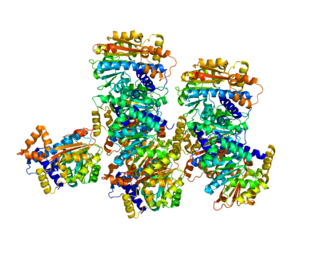Zinc finger protein 451 is a novel nuclear protein that in humans is encoded by the ZNF451 gene. [5] [6]
Zinc finger protein 451 is a novel nuclear protein that in humans is encoded by the ZNF451 gene. [5] [6]

G-protein coupled receptor family C group 5 member C is a protein that in humans is encoded by the GPRC5C gene.

Ribonuclease P protein subunit p38 is an enzyme that in humans is encoded by the RPP38 gene.

Zinc finger protein 655 is a protein that in humans is encoded by the ZNF655 gene.

Ubiquitin carboxyl-terminal hydrolase 33 is an enzyme that in humans is encoded by the USP33 gene.

Nuclear receptor-binding factor 2 is a protein that in humans is encoded by the NRBF2 gene.

RING finger protein 37 is a protein that in humans is encoded by the UBOX5 gene.

Zinc finger protein 219 is a protein that in humans is encoded by the ZNF219 gene.

Zinc finger protein 649 is a protein that in humans is encoded by the ZNF649 gene on Human Chromozone 19 containing 5 exons.

Glutaredoxin-3 is a protein that in humans is encoded by the GLRX3 gene.

Zinc finger and BTB domain-containing protein 20 is a protein that in humans is encoded by the ZBTB20 gene.

Zinc finger protein 330 is a protein that in humans is encoded by the ZNF330 gene.

KIAA1166 is a human gene.

RWD domain-containing protein 2B is a protein that in humans is encoded by the RWDD2B gene.

Dynein light chain 4, axonemal is a protein that in humans is encoded by the DNAL4 gene.

Leucine carboxyl methyltransferase 1 is an enzyme that in humans is encoded by the LCMT1 gene.

NADH-cytochrome b5 reductase 1 is an enzyme that in humans is encoded by the CYB5R1 gene.

Akirin-2 is a protein that in humans is encoded by the AKIRIN2 gene.

E3 ubiquitin-protein ligase RNF25 is an enzyme that in humans is encoded by the RNF25 gene.

Zinc finger protein 193 is a protein that in humans is encoded by the ZNF193 gene.

Centrosomal protein of 70 kDa is a protein that in humans is encoded by the CEP70 gene. The protein interacts with γ-tubulin through its coiled coil domains to localize at the centrosome. CEP70 is involved in organizing microtubules in interphase cells and is required for proper organization and orientation of the mitotic spindle.
This article incorporates text from the United States National Library of Medicine, which is in the public domain.